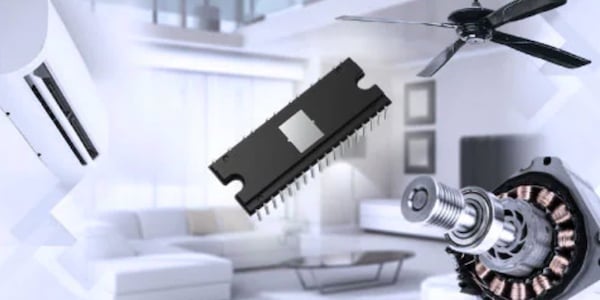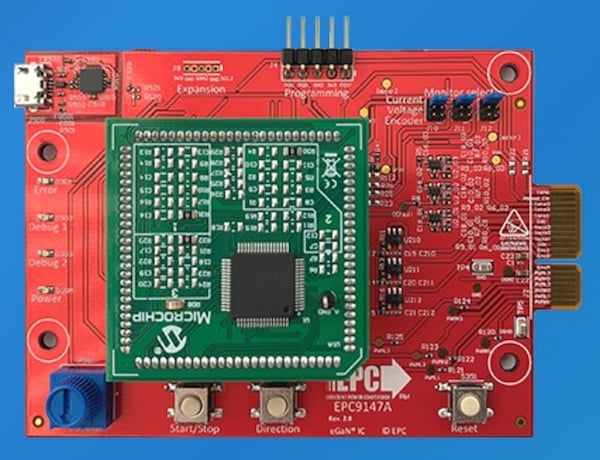ST, Toshiba, and EPC Offer Enhanced Support for Motor Drive Applications
ST Microelectronics, Toshiba, and EPC are responding to the increasing demand for motor drive circuits that are economical, efficient, and deliver high performance.
The era of basic, single-speed alternating current appliance motors is a thing of the past. In an effort to maximize the output from our constrained power infrastructure, manufacturers of devices are now embracing sophisticated digital control electronics and motor systems with enhanced efficiency.

Toshiba TP416XK in through-hole package
Motor drives operate on the ambiguous boundaries of digital electronics, where they frequently deal with low frequencies—often just tens of kilohertz. In such scenarios, timing and tolerance issues are usually not a concern. Nevertheless, these drives are connected to high-current motors that act as dynamic sources of erratic electromagnetic interference (EMI), electromotive forces (EMF), and various forms of noise. This unique overlap of digital and analog realms, coupled with the unpredictable elements of EMI, infuses a touch of 'magic' into the design of motor drive electronics. Frequencies that are too low can lead to audio disturbances and overheating of the motor's wiring, whereas too high frequencies contribute to substantial switching losses, which in turn lead to inefficient power consumption and additional heat generation in the electronic components. Timing, therefore, requires meticulous management to harmonize current shoot-through, turn-off, and turn-on times.Here are three examples that showcase how the industry is striving to refine the art of motor control.
STMicroelectronics Debuts High-Current Integrated Motor Driver Line
Introducing the newest addition to their motor driver offerings, STMicroelectronics unveils the STSPIN9 series, featuring integrated solutions. The initial models in the series are equipped with a robust 58-V power stage, precise PWM control logic, and current-detection capabilities. These drivers are specially designed for top-tier industrial, domestic, and professional appliances, demonstrating ST's commitment to catering to high-performance motor drive applications.

STSPIN line of motor controllers
STMicroelectronics Introduces the Versatile STSPIN9 Motor Driver Family
STMicroelectronics has expanded its motor driver portfolio with the release of the STSPIN9 series, featuring the 4.5-A STSPIN948 and the 5-A STSPIN958. The STSPIN948 is a versatile driver with dual full-bridge (H-bridge) configurations, making it suitable for brushed DC motors or bipolar stepper motors. It offers the flexibility of five different full-bridge and half-bridge driving modes, allowing for a wide range of motor control possibilities.
On the other hand, the STSPIN958 comes with a single full-bridge capable of operating in seven distinct modes, including dual independent half-bridges, dual parallel half-bridges for increased current delivery, or a unified H-bridge setup.
Both models boast low standby current usage, protection features against low and under-voltage conditions, over-current events, and overheating, with thermal shutdown mechanisms in place. They have impressive on-resistance (RDS(on)) values of .36 and .33 ohms, respectively, which benefits power efficiency. Additionally, they incorporate current sensing amplifiers, adjustable slew rates for power MOS components, and modifiable off-time controls that cater to either slow or mixed decay modes.
The reconfigurability of the high-current output stages in these devices provides substantial adaptability, addressing a frequent concern regarding the rigidity of fully integrated systems. With these flexible output configurations, manufacturers can streamline their product lines with fewer unique variants, while motor control engineers gain a broader array of options before needing to resort to discrete component designs.
Toshiba Replaces Induction Motors With BLDC
The Toshiba TP416XK are self-contained sensorless brushless DC (BLDC) motor drive chips. They include integrated bipolar transistors (IGBTs), drive transistors, gate drives, internal 5V-regulators, current sense and over-current protection, and input logic in one package. They take microcontroller logic level signals and drive BLDC motors at up to 600 V with minimal external componentry. The TPD4163K delivers DC current rated to 1 A, and the TPD4164K delivers 2 A.

Block diagram of the TPD4163K
The BLDC is replacing AC motors in most appliances. Past installations put inexpensive single-phase AC induction motors into most appliances. With the need to manage EMI and power usage, OEMs use more efficient systems, such as multi-phase brushless DC motors, more often. This series of drivers from Toshiba targets the installation of BLDC motors in air conditioners, air handlers, and pumps.
EPC Takes the GaN Route for Smaller Motor Drivers
Gallium nitride (GaN) has been in the news a lot lately for its ability to deliver the same or better performance as silicon in a smaller package. EPC has just announced a three-phase brushless DC (BLDC) motor driver evaluation board, the EPC9194, that demonstrates more than 2x power-to-weight improvement with their parts compared to silicon MOSFETs.
At the heart of the EPC reference design are six (two per phase) EPC2302 enhancement-mode, gallium nitride field-effect transistors (eGaN FETs). It sports a 1.8 mΩ maximum RDS(on), allowing it to deliver a 100-V drain-to-source rating at 101 A continuously. GaN allows for higher voltages, higher current, and faster switching speeds than silicon MOSFETs and is often simpler to drive. This allows EPC to address motor drive efficiencies with a lower overall system cost.
A motor driver is generally paired with a microcontroller when being tested or implemented. The new eval board comes in several versions optimized for different microcontrollers. Most engineering departments, and most individual engineers, have a set of microcontrollers that they are comfortable with and experienced in. While the basic motor control concepts don’t change with the drive electronics, the specific mechanisms and software code will vary based on the selected microcontroller family.

EPC9147A development board tailored for Microchip MCUs
EPC hopes to speed the adoption of its eGaN devices by reducing as many obstacles for design engineers as possible, and having development boards optimized for popular MCU families is a good step in that direction.
Motor Controls and Power Savings
Motor controls are one of the unsung heroes of the modern world. We hear about power requirements for server farms, electric vehicles, and air conditioning as major opportunities for power savings, but motors are in just about everything these days. We just don’t tend to think much about them. Implemented poorly, motors contribute to electromagnetic noise and power consumption. The ability to drive motors more efficiently, as these three announcements address, allows engineers to get more out of their motors with a smaller overall footprint.







